Remembrance Gathering: 4 pm, May 2, 2014, Alumni House, UC Berkeley
Sydney Kustu, Microbiologist
By Bob B. Buchanan, Department of Plant and Microbial Biology, UC Berkeley
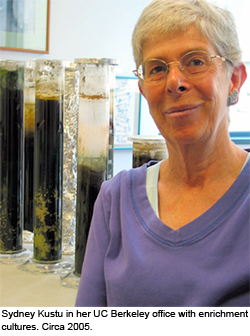
Professor Emerita Sydney Govons Kustu, a distinguished scientist, a driving force behind the development of microbiology on the UC Berkeley campus, and a trailblazer for women in science, died in Berkeley on March 18, 2014. She was 71.
Kustu’s research had broad implications. Among her many contributions to microbial genetics and physiology, Kustu was best known for her work on the regulation of nitrogen metabolism, specifically how bacterial genes are regulated by the level of nitrogen-containing compounds in the environment. She was a strong advocate for young scientists, and mentored numerous students and other researchers during her career.
Sydney Kustu was a stellar scientist. Working with a small research group, she made lasting contributions to microbiology. Her work is now part of the fabric of knowledge of genetics, metabolism and nutrition. A true intellectual, she read widely and attended seminars broadly. Without fail she asked the penetrating question that either clarified the issue under discussion or showed the need for additional evidence—in some cases in a pointed manner.
Kustu garnered a large number of awards during her career. She was elected a member of the National Academy of Sciences and a fellow of the American Academy of Arts and Sciences, the American Association for the Advancement of Science, and the American Academy of Microbiology. She was awarded a prestigious Gauss Professorship by the Göttingen Academy of Sciences and a Miller Professorship by UC Berkeley. She also was honored with a MERIT (Method to Extend Research in Time) award from the National Institutes of Health (NIH), which recognizes researchers who have demonstrated superior competence and outstanding productivity and guarantees funding for 10 years. Less than 5 percent of NIH-funded investigators are selected to receive MERIT awards.
Education
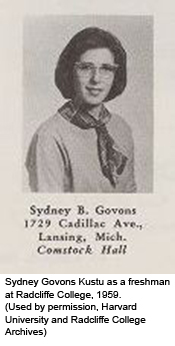 Sydney Kustu completed her undergraduate studies at Harvard College in 1963. Amrita Hazra, a postdoctoral researcher in the Department of Plant and Microbial Biology (PMB) at UC Berkeley, remembers when Kustu told her that she was among the first “official” Harvard class of women.
Sydney Kustu completed her undergraduate studies at Harvard College in 1963. Amrita Hazra, a postdoctoral researcher in the Department of Plant and Microbial Biology (PMB) at UC Berkeley, remembers when Kustu told her that she was among the first “official” Harvard class of women.
“Until then, Radcliffe College and Harvard College were all-female and all-male colleges respectively,” Hazra said. Radcliffe was Harvard's "coordinate institution for female students" until 1963, when the degree was jointly conferred. After completing her BA at Harvard Kustu spent two years as a technician in the laboratory of Saul Roseman at the University of Michigan, where she received training in the purification and kinetic characterization of enzymes.
Kustu earned her doctorate in biochemistry with Professor Jack Preiss at UC Davis in 1970. “I would consider Sydney one of the brightest if not the brightest of the over 100 researchers (postdoctorals, sabbatical professors and 30 graduate students) present in my laboratory in my 45 years as an active faculty member. She was liked by everyone, and all appreciated her ideas and provoking thoughts in the group research discussions that we had. Her efforts and results were very important in my having a research program that NIH supported for over 36 years,” he said.
After completing her doctoral thesis, Kustu joined the laboratory of Professor Giovanna Ames at UC Berkeley. “Sydney was a superb experimentalist with golden hands,” Ames said. “Her intuition and expansive view of scientific matters turned all experiments into a perfectionist’s game of foreseeing all possibilities and complications, addressing them in advance, and composing an experiment somewhat like a piece of music, and then having a great deal of fun interpreting the results critically and planning further.“
UC Davis Faculty
In 1973 Kustu was hired as assistant professor of bacteriology at UC Davis, where she initiated her pioneering studies of nitrogen metabolism in enteric bacteria. She was promoted to full professor in 1984. In addition to launching her research and teaching career, she assumed a prominent role in promoting and co-organizing the West Coast Bacterial Physiologists annual meeting held at the Asilomar Conference Center in Pacific Grove, California. She continued in this capacity for the greater part of the next two decades. In 2011 her efforts were recognized by a special symposium organized to honor her and her many contributions to microbial physiology.
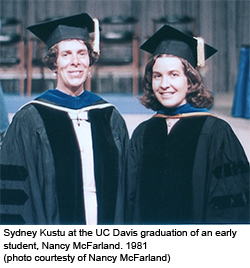 “While at Davis, Sydney established herself as a skilled, articulate, admired teacher,” said Professor Emeritus John Ingraham, speaking on behalf of the UC Davis Department of Microbiology and Molecular Genetics. I never heard any of her students offer her anything but praise and affectionate admiration.” This impression was confirmed by David Popham, now on the faculty at Virginia Tech, who applauded Kustu’s high standards and dedication to science, her “higher calling.” She was also known for her insistence on clear and concise writing.
“While at Davis, Sydney established herself as a skilled, articulate, admired teacher,” said Professor Emeritus John Ingraham, speaking on behalf of the UC Davis Department of Microbiology and Molecular Genetics. I never heard any of her students offer her anything but praise and affectionate admiration.” This impression was confirmed by David Popham, now on the faculty at Virginia Tech, who applauded Kustu’s high standards and dedication to science, her “higher calling.” She was also known for her insistence on clear and concise writing.
From the outset of her career Kustu applied the power of a genetic approach to answer biochemical questions. According to Ingraham, “Her major research achievement was unraveling the complex, interconnected mechanisms that regulate nitrogen utilization by bacteria. She found that strains selected for being able to utilize D-histidine in place of the L isomer frequently resulted from mutations affecting the activity of glutamine synthetase, a central enzyme in the pathways of nitrogen utilization.” This genetic tool led her to investigate the regulation of nitrogen utilization, then an active area of research led by a prestigious group of established investigators.
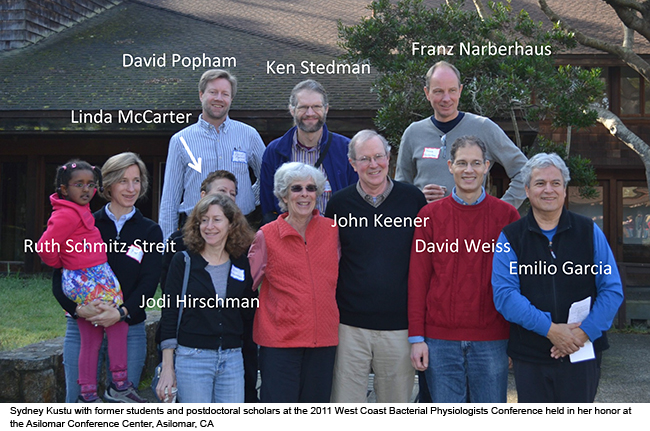
Conventional wisdom of the time held that glutamine synthetase was its own regulator as well as the key controller of nitrogen metabolism. Over the next several years, in a series of paradigm-altering papers, Kustu and her students showed that this was not the case. Rather, as they discovered, regulation of the synthesis of glutamine synthetase and utilization of various sources of nitrogen that might be available to a bacterium is mediated by a consortium of three regulatory proteins. These interact to activate or repress synthesis of enzymes catalyzing various routes of nitrogen utilization appropriate to extant environmental conditions.
“Sydney solved a fundamental puzzle of nitrogen regulation,” Ingraham concluded. She would go on to explore the mechanism and regulation of the so-called nitrogen “Ntr” regulatory proteins in great detail.
UC Berkeley Faculty
In 1986 Kustu was recruited to UC Berkeley, where she helped lead the effort to revive and strengthen microbiology on campus. Her efforts culminated with the establishment of the Division of Microbiology within PMB.
Kustu continued her teaching and mentoring contributions – areas in which she excelled – while on the Berkeley faculty. N. Louise Glass, a PMB colleague who took Kustu’s microbiology course at Davis, recalls that “Sydney Kustu was particularly beloved by PMB undergraduate students. Throughout her career, she was an effective and dedicated teacher at both the undergraduate and graduate levels. Her use of the Socratic method for teaching concepts in microbiology was particularly effective and inspiring." Madeline Ferwerda, who took a genetics class from Kustu in 2000 as a undergraduate, added that “She was inspiring because she was aware of the social undercurrents in science, and she was willing to speak about them.”
Her graduate students also speak of the lasting effect Sydney had on their lives. David Weiss, now a faculty member at the University of Iowa, was the first student to join her laboratory after she moved to Berkeley. He recalls, “Sydney was my most important scientific mentor. Her enthusiasm for science made working in her lab an exhilarating experience. Even though we were working with DNA and proteins, she never lost sight of the organism.” Weiss's colleague at Iowa, Linda McCarter, who was a graduate student with Kustu at Davis, echoes these sentiments. “Sydney will always be my favorite and best role model for being a scientist. She once wrote: ‘I never could see the point of working if it wasn't to the absolute best of my ability!’ Her fierce intelligence unfailingly led her to the crux of every problem, her expectation for excellence was always inspiring, and her keen joy in science and the world was a great pleasure and privilege to share.”
Kustu continued her pioneering research on the regulation of nitrogen metabolism following her move to Berkeley. Driven by her enduring interest in bacterial physiology, she eventually turned to questions of how bacteria obtain and metabolize various nitrogen-containing compounds. These studies led to important insights into the transport mechanism of the Amt family of ammonium channels as well as to the discovery of a new central metabolic pathway, the Rut system for degradation of pyrimidines.
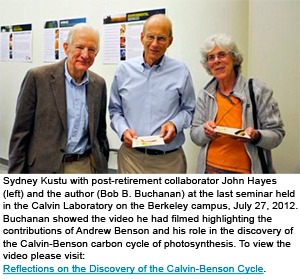 A scientist who looked to solve problems with genetics and biochemistry first, Kustu was fearless in applying other disciplines to answer fundamental questions. When she lacked the necessary expertise, she formed collaborations with talented colleagues to arrive at solutions. The wisdom of this approach was evident throughout her career, but was particularly apparent during her tenure at UC Berkeley.
A scientist who looked to solve problems with genetics and biochemistry first, Kustu was fearless in applying other disciplines to answer fundamental questions. When she lacked the necessary expertise, she formed collaborations with talented colleagues to arrive at solutions. The wisdom of this approach was evident throughout her career, but was particularly apparent during her tenure at UC Berkeley.
According to David Wemmer, a professor in the UC Berkeley Department of Chemistry and collaborator of Kustu’s, “Her enthusiasm and tenacity in tackling scientific problems were remarkable.” He cited their collaborative work on both the nitrogen regulatory protein C (NtrC) and the Rut system as examples of “Sydney’s integration of her tools in genetics and biochemistry with complementary methods to advance the understanding of a complex system.”
A Champion for Women in Science
In 1993, Kustu and six other women were elected to the National Academy of Sciences, representing a significant rise in the number of women inducted over prior years. “Before 1980, very few women were elected to the National Academy, which embodies the highest level of achievement for a scientist, excluding the Nobel Prize,” said a colleague, PMB Professor Pat Zambryski, also a member of the Academy. At the time of Kustu’s election females accounted for less than five percent of Academy membership. Kustu was particularly proud of her inclusion in the Academy because, in her own words, “at one time it was forbidden fruit for women to do science." Since Kustu’s election, female representation in the Academy has more than tripled. Women now account for 13% of the membership.
Likewise, “When Kustu joined the Berkeley faculty in the mid-1980s there were very few women in our department,” Zambryski said. “Now women faculty in PMB represent an impressive 40 percent.” Informed by her own early career experience of how women faculty were not always treated as equals, Sydney made a point of reaching out and mentoring every young woman faculty who joined PMB. “This led to institution of a mentorship program in our department where all new faculty members (male or female) are paired with an appropriate and supportive senior faculty member,” Zambryski added.
Kustu mentored numerous female graduate students and postdocs who went on to productive careers. Ruth Schmitz-Streit, currently a professor at Christian-Albrecht’s University in Kiel, Germany, and Kustu’s host in Göttingen for the Gauss Professorship, was greatly influenced by Kustu’s expertise and guidance in genetics as a postdoc in the 1990s. Schmitz-Streit also benefited from Kustu’s advice on “how to survive as a female professor in a mainly male-dominated scientific world.” She recalls Kustu’s advising her “to get the most out of time by plotting strategies about science projects while doing boring work like laundry. Even now nearly 20 years later I find myself following her advice instinctively, and when realizing this, I involuntarily have to smile while remembering Sydney.”
Broad interests
In addition to research, teaching and mentoring, Kustu was passionate about the arts and nature. She organized outings with friends and colleagues to Zellerbach Hall on the Berkeley campus and to museums in San Francisco, and often attended movies played at the Pacific Film Archives. She was particularly attracted to Southern literature and was a fan of Walker Percy and Shelby Foote. Her interest in the arts and literature was reflected in her service on the Library Committee of the Academic Senate. An avid hiker, Kustu made it a point to take daily long walks in and around Berkeley. Always gracious and likeable upon first interaction, she was very supportive of those in need of comfort and assistance. She also had particularly strong feelings for the infirm and the down-and-out.
Kustu retired from the University in March 2010, and was appointed Professor Emerita. She is survived by her son, Saul Kustu of Aptos, CA, and two sisters, Roberta Glassman of Calabasas, CA, and Marica Govons of Belmont Shores, CA.
Bob B. Buchanan is a professor emeritus in the Department of Plant & Microbial Biology.
Additional reporting by Ann Brody Guy, Jason Hall, Karyn Houston and David Weiss.
Gifts in memory of Sydney Kustu can be made online at givetocal.berkeley.edu.
Or, checks, made out to UC Berkeley Foundation, can be mailed to Bernadette Powell, Development Officer, College of Natural Resources, 112 Giannini Hall, UC Berkeley, CA 94720-3100.
Questions? Contact Bernadette Powell at powell@berkeley.edu or call 510.643.9903.
